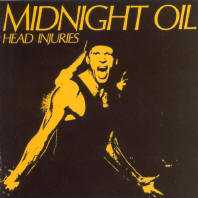This article is about a music recording.
For trauma to the head, see
Head injury.
Head Injuries is the second studio album by Australian pub rockers, Midnight Oil, which was released in October 1979 on their own Powderworks label and distributed by Columbia Records. The album was produced by Leszek J. Karski. It was the last Midnight Oil album to feature founding bass guitarist, Andrew James, who quit the band due to illness. It peaked at No. 36 on the Australian Kent Music Report and by mid-1980 had achieved gold status.
The Midnight Oil logo with the open hand, as seen on the cover of Scream in Blue and in all other albums, comes from a photo in the liner notes of this album.
Background
Head Injuries is the second studio album by Australian rock band, Midnight Oil. They had formed in 1971 with Rob Hirst on drums, Andrew James on bass guitar, and Jim Moginie on keyboards and lead guitar.[1][2] By 1972 they added Peter Garrett on vocals and synthesiser.[1][3] The group began to develop an aggressive, punk-hard rock sound for their pub rock audiences.[3] In 1977 Martin Rotsey joined on guitar.[2] Their debut eponymous album, Midnight Oil, was released by their own label, Powderworks, in November 1978.[4] The band built a dedicated fan base, initially restricted to Sydney, which was extended to other Australian cities through constant touring – performing some 200 gigs in their first year.[3] They became known for their furious live performances, which featured the two guitarists Moginie and Rotsey, the drumming and backing vocals of Hirst and the presence of the towering, bald Garrett as lead singer.[1][3] The first album had disappointed some critics as it did not capture their powerful live performances, with undemanding playing and Garrett’s vocals sounding stilted.[1]
In October 1979 Head Injuries was released on Powderworks, it was produced by former Supercharge member, Leszek J. Karski.[2] It mixed solid guitar rock with progressive flourishes and was an improvement by highlighting the group’s strengths and growth.[1][3] It peaked at No. 36 on the Australian Kent Music Report and by mid-1980 had achieved gold status.[1][4] In April 1980 founding bass guitarist James left because of ill-health and was replaced by Peter Gifford (ex-Huntress, Ross Ryan Band).[2] Further interest in Midnight Oil was generated by the popular Bird Noises EP, also produced by Karski, which peaked at No. 28 on the Australian singles charts.[4] One of its four tracks was the surf-instrumental "Wedding Cake Island" named after the rock outcrop in the ocean off Sydney's Coogee Beach. The band's third LP Place without a Postcard, was released by CBS Records in November 1981.[2][3]
Reception
| Professional ratings |
|---|
|
|
|
| Review scores |
| Source |
Rating |
| Allmusic |
     link link |
|
|
|
|
|
|
|
|
|
|
|
|
|
|
|
|
|
|
|
Track listing
|
| 1. |
"Cold Cold Change" | Rob Hirst, Jim Moginie |
3:29 |
| 2. |
"Section 5 (Bus to Bondi)" | Martin Rotsey, Hirst, Peter Garrett, Moginie |
3:04 |
| 3. |
"Naked Flame" | Rotsey, Hirst, Moginie |
3:27 |
| 4. |
"Back on the Borderline" | Andrew James, Garrett, Hirst |
3:09 |
| 5. |
"Koala Sprint" | Garrett, Moginie, Rotsey |
5:12 |
| 6. |
"No Reaction" | Hirst, Moginie, Rotsey |
2:59 |
| 7. |
"Stand in Line" | Moginie, Hirst, Rotsey, Garrett |
4:48 |
| 8. |
"Profiteers" | Hirst, Moginie, Rotsey |
3:46 |
| 9. |
"Is It Now?" | Moginie, Garrett |
4:20 |
Personnel
- Additional personnel
- Leszek J. Karski - producer
- Peter J. Walker - engineer
References
External links
|
|---|
| | | | Studio albums | |
|---|
| | Charting singles |
- 1978
- "Powderworks"
- "Run by Night"
- 1979
- "Cold Cold Change"
- 1980
- "Back On The Borderline"
- "Section 5 (Bus To Bondi)"
- 1981
- "Don't Wanna Be the One"
- "Armistice Day"
- 1982
- "Power and the Passion"
- "Read About It"
- 1983
- "US Forces"
- 1984
- "When General Talks"
- 1985
- "Best Of Both Worlds"
- 1986
- "The Dead Heart"
- 1987
- "Beds Are Burning"
- " Put Down that Weapon"
- "Dreamworld"
- 1990
- "Blue Sky Mine"
- "Forgotten Years"
- "King of the Mountain"
- "Bedlam Bridge"
- 1991
- "One Country"
- 1992
- "Scream In Blue (Live)"
- "Sometimes"
- 1993
- "Truganini"
- "My Country"
- "In the Valley"
- "Drums of Heaven"
- "Outbreak of Love"
- 1996
- "Underwater"
- "Surf's Up Tonight"
- 1998
- "Redneck Wonderland"
- "White Skin Black Heart"
- "Cemetery In My Mind"
- 2000
- "The Real Thing"
- 2002
- "Golden Age"
- "Too Much Sunshine"
- "Mosquito March"
- "Luritja Way"
|
|---|
| | Compilations and EPs | |
|---|
| | Live and other albums | |
|---|
| | Videos and films | |
|---|
| | Additional personnel | |
|---|
| | Related articles | |
|---|
|
-
 Category Category
|
|
